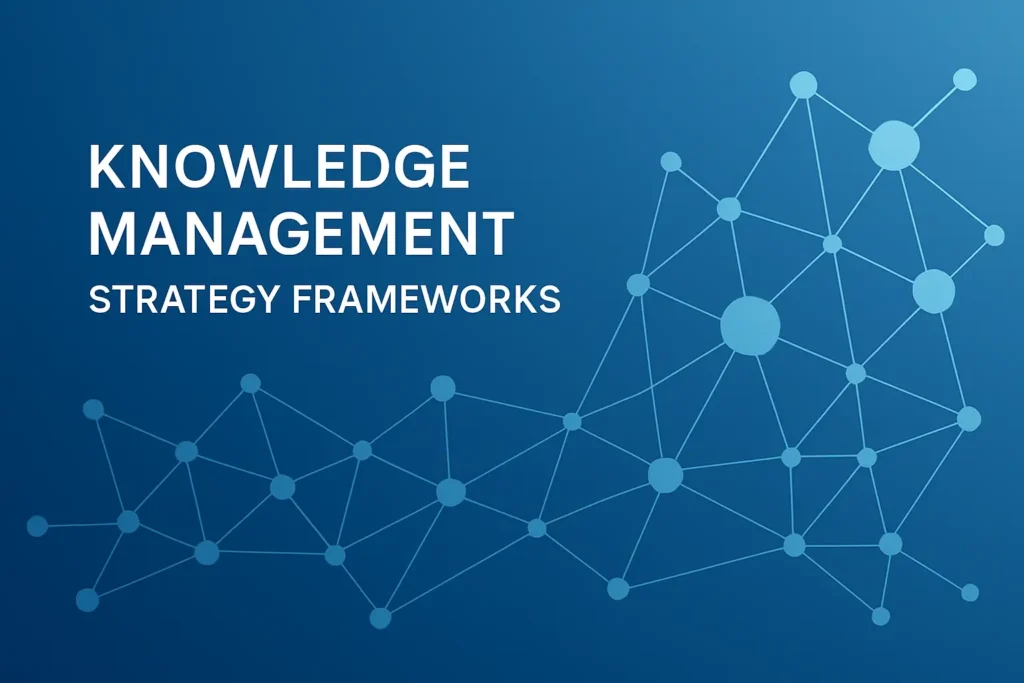A well-designed knowledge management (KM) strategy framework can be the difference between organizational knowledge thriving or stagnating in silos. While every enterprise needs a framework, the challenge is choosing the right model for your unique business environment.
This article explores the top five KM strategy framework models, how they work, and how organizations can adapt them for maximum impact. By understanding these models, KM professionals can design systems that not only store knowledge but actively drive decision-making, collaboration, and innovation.

Knowledge Management Strategy Framework Models
1. APQC Process Classification Framework
The APQC (American Productivity & Quality Center) Process Classification Framework is one of the most widely adopted KM frameworks globally.
Key Features:
- Standardizes business processes across industries.
- Provides a taxonomy for organizing knowledge assets.
- Encourages benchmarking against best practices.
Why It Works:
APQC helps organizations align knowledge with operational processes, enabling better decision-making and improved efficiency. Companies like Siemens and Johnson & Johnson leverage it to streamline process documentation and knowledge reuse.
2. Nonaka-Takeuchi SECI Model
The SECI Model—Socialization, Externalization, Combination, Internalization—is a dynamic approach to knowledge creation.
Key Features:
- Emphasizes the conversion of tacit knowledge (personal expertise) into explicit knowledge (documents, manuals).
- Promotes continuous knowledge exchange across teams.
- Encourages learning through social interactions, collaboration, and reflection.
Why It Works:
This model is ideal for organizations focused on innovation, research, and creative problem-solving. Toyota and Hitachi have applied SECI principles to foster a culture of continuous improvement and knowledge sharing.
3. Deloitte Knowledge Management Framework
Deloitte’s framework is designed for professional services firms but is adaptable to large enterprises in other sectors.
Key Features:
- Focuses on integrating knowledge management with business strategy.
- Provides guidelines for capturing, curating, and applying knowledge.
- Includes metrics to measure knowledge impact on business outcomes.
Why It Works:
It bridges the gap between knowledge repositories and business decisions. Deloitte uses this framework internally to enhance client advisory services and improve project outcomes.
4. Gartner Knowledge Management Framework
The Gartner KM Framework focuses on aligning knowledge assets with enterprise goals.
Key Features:
- Emphasizes governance, metrics, and adoption.
- Provides a maturity model to assess KM effectiveness.
- Encourages integration of technology, processes, and people.
Why It Works:
Enterprises benefit from a structured approach to evaluate and improve their KM initiatives. The framework is particularly useful for organizations looking to measure ROI and track adoption of KM practices.
5. KPMG Knowledge Management Value Chain
KPMG’s approach positions knowledge as a strategic asset throughout the business lifecycle.
Key Features:
- Captures knowledge at each stage: creation, storage, sharing, application.
- Links knowledge directly to value creation and business outcomes.
- Supports global enterprises with complex operations.
Why It Works:
This framework emphasizes the business impact of KM, helping organizations connect knowledge initiatives to revenue, efficiency, and innovation.
Choosing the Right KM Strategy Framework
Selecting a framework depends on organizational goals, culture, and resources. Consider these factors:
- Business objectives: Are you focused on operational efficiency, innovation, compliance, or all three?
- Organizational culture: Does your company emphasize collaboration, hierarchical decision-making, or decentralized operations?
- Technology maturity: Are your KM tools ready to support semantic search, AI, or real-time analytics?
- Measurement and governance: Do you have KPIs in place to track KM success?
Many organizations adopt a hybrid approach, blending elements from multiple frameworks to suit their unique context.
Best Practices for Implementation
- Start with a clear strategy – Align your framework with enterprise goals.
- Engage stakeholders early – Ensure buy-in from leaders, managers, and employees.
- Focus on people and culture – Tools alone won’t ensure knowledge sharing.
- Leverage technology effectively – Use AI, search, and collaboration platforms to enhance accessibility.
- Measure impact continuously – Track KPIs such as knowledge reuse, time saved, and decision quality.
Conclusion
Choosing the right knowledge management strategy framework is critical for enterprises aiming to turn knowledge into tangible business value. Whether it’s APQC’s standardized processes, SECI’s dynamic knowledge creation, or Deloitte’s strategic integration, the key is adapting the model to your organization’s needs.
By understanding these frameworks and applying best practices, KM leaders can ensure that knowledge flows seamlessly, supports decision-making, and contributes to innovation, efficiency, and long-term competitive advantage.
Read: Knowledge Management Strategy Framework: A Step-by-Step Guide for Enterprises
